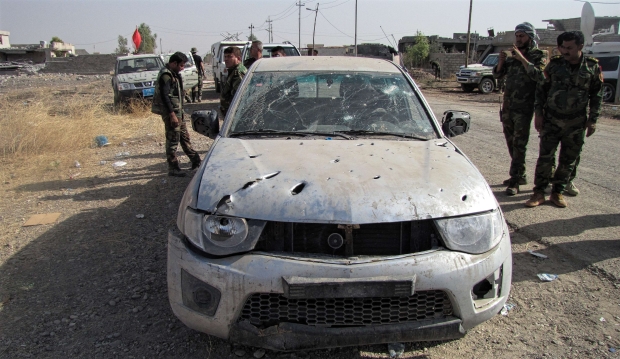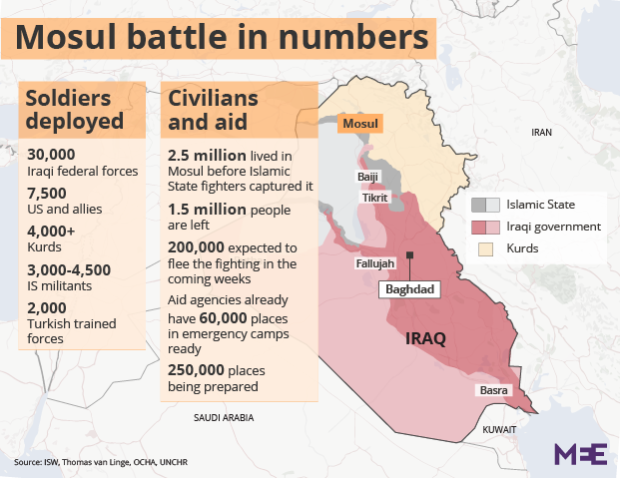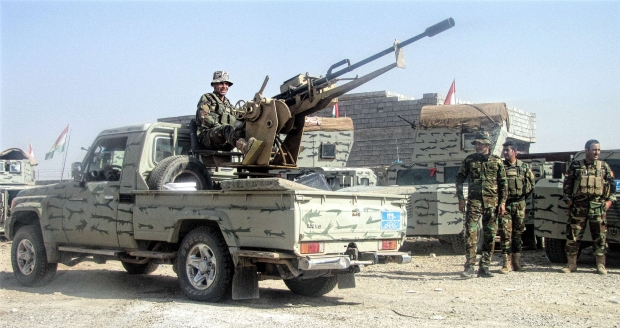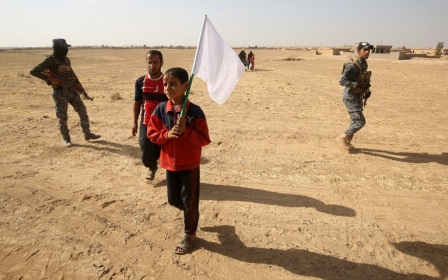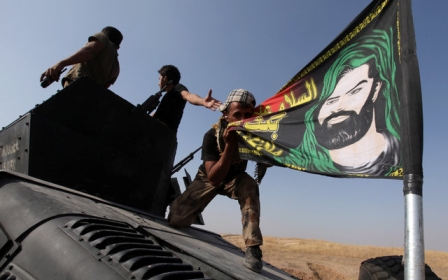Mosul offensive: Suicide bombers, scorched fields and adrenaline
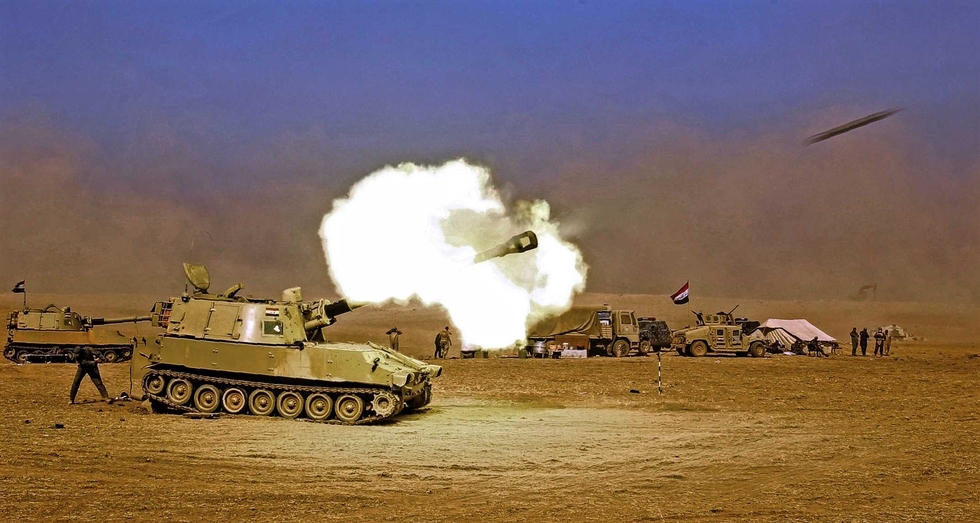
KHAZER, Iraq - On the road to the village of Barzakat, some 15km from Mosul, sat a deserted, bullet-riddled pick-up.
On Tuesday morning, the Islamic State (IS) vehicle was stopped by Peshmerga fighters wielding automatic rifles. Eight IS militants were riding in the pick-up: four of them were killed, then buried by the Kurds a hundred metres from where they fell.
The remaining four managed to get away. At time of writing, the Kurdish fighters were looking for them in the ruins of nearby villages.
'Around here, everything is riddled with mines – absolutely everything!'
- Muquadem Said, Kurdish officer
Out in the open, the Iraqi-Kurdish coalition's troops are vulnerable to artillery or suicide attacks. The enemy could strike at any time.
Muquadem Said is an officer with the Fifth Regiment of the Zeryhwan Kurdish division. "Our biggest problems are the suicide bombers," he said, "the car bombs and the mines. Around here, everything is riddled with mines – absolutely everything!
"That is why our progress over the last two days has been so slow. Our units have to clear out the villages, only then can we move on."
On Wednesday, the area around Barzakat was one of the furthest eastern frontlines within the current scope of the offensive.
American military planes scorched the sky above. Their main function was bombing IS positions in the city and its surroundings. Now and then, heavy artillery joined in to pound Iraq's second-biggest city.Smoke seemed to rise up everywhere. During the last three days, at least a dozen nearby villages were razed to the ground by air raids. Reduced to rubble, these hamlets are now counted as "liberated".
In one village, I came across a nearly petrified little boy staring off into space
In one of them, I came across a petrified little boy staring off into space. In another, all I could find was a pair of sheep. What walls remained in these settlements were covered with IS graffiti, something that has long been a part of the group's folklore.
Disfigured animal carcasses littered the craters on freshly bombed roads. In the middle of a two-lane thoroughfare, an unexploded rocket stuck up vertically from the sand. The Kurdish fighters had decided to mark it with a small red flag.
Everywhere, soldiers dug trenches or set up defensive mounds of sand. Kilometres and kilometres of grass and fields had been scorched, part of the IS plan to try and stop bombers with fire and smoke. Hot winds roiled the desert sands.
Two government Black Hawk choppers flew over the frontline at a dangerously low altitude. They could easily have become a pair of targets, as they completed an unnecessary manoeuvre even the most inexperienced pilots shouldn't be excused for attempting.
Congestion puts lives at risk from attack
Chaotic traffic flowed in all directions, both towards the front line and away from it. Here, where it is least needed, potentially dangerous knots of congestion constantly formed. A single grenade or rocket from IS positions could easily massacre a dozen or more men.
Reinforcements kept rolling towards the front line, which is jointly controlled by Kurdish fighters and the soldiers of the Iraqi government. Many of the new arrivals were volunteers, who'd simply picked up a weapon and gone off to fight against IS.
The images on the main road from Erbil to Mosul reminded me of 2003, the first fall of Mosul, when the city became a hot destination for robbers and other sorts of war tourists.
The convoy clearly didn't have time for the traffic chaos on all sides, with those in front quick to let everyone know that they had the right of way. Left and right, people threw themselves into the dirt to escape.
The drivers, many of whom were themselves refugees, swerved in something akin to panic. Even soldiers of the Kurdish Regional Government (KRG) were giving way.At the Mosul front line, more than 10,000 of them were assembled. The number could easily double in the foreseeable future.
The chaos of frontline life
Muquadem Said believes that the anti-IS forces have "done well" so far, but that the battle for Mosul will be long and rough.
"We've now come to a halt," the officer said. "Only the Iraqi army can go on. This is the deal struck by Erbil and Baghdad. It is a deal we're going to respect."
What matters, he said, is the eventual retreat of IS from Mosul, something that is of paramount importance for the entire Middle East. As things stand, the Kurds are not allowed into downtown Mosul. The same goes for the Shia militias. But the conditions at the frontline are so chaotic that virtually anything could happen.
Even now, in its early phases, at least 30,000 troops have been deployed – Kurds, government troops, Iraqi and Iranian Shia militiamen, volunteers.
"We are cooperating well," Said said. "No one is allowed to act without consulting the others. We have a common enemy and a common goal.
A single grenade or rocket from the IS positions could easily have massacred a dozen or more men
"The majority of the Islamic State forces scattered as soon as they saw us coming. Then they sent in the suicide bombers.
"They're terrified of us. They know very well what we're capable of in battle. The Kurds, we know very well how to deal with them!"
The real battle is only just beginning
Said's soldiers were doing their best to set up temporary shelter in the nearby houses (or those that had somehow survived the coalition bombing). During this brief intermission, the engineering corps did their best to service the armoured vehicles. Most of the vehicles were of American origin, though a number of them had apparently been home-made in local workshops and kitted out Mad Max style.
The images we gathered through the day across the front line had a post-apocalyptic feeling.
They will have to claw their way into the tunnel-riddled Mosul city centre, which is said to be heavily mined
Many of them were seasoned veterans from battles of the '80s and '90s. On average, the Kurdish fighters were older than the Iraqi government troops. Many of the latter looked disquietingly wet behind the ears, yet the brunt of the heavy fighting is sure to land on their shoulders.
They are the ones who will have to claw their way into the tunnel-riddled Mosul city centre, which is said to be heavily mined.
The real battle for Mosul is just beginning.
This article is available in French on Middle East Eye French edition.
Middle East Eye propose une couverture et une analyse indépendantes et incomparables du Moyen-Orient, de l’Afrique du Nord et d’autres régions du monde. Pour en savoir plus sur la reprise de ce contenu et les frais qui s’appliquent, veuillez remplir ce formulaire [en anglais]. Pour en savoir plus sur MEE, cliquez ici [en anglais].


